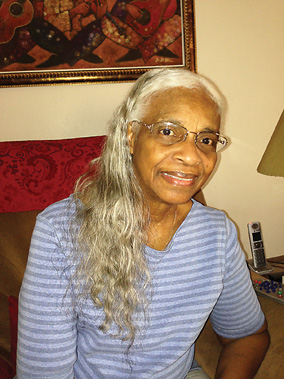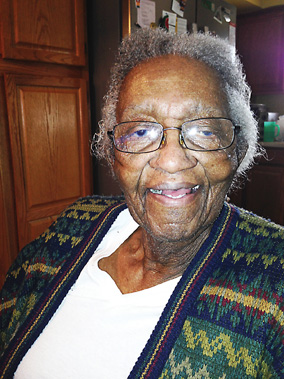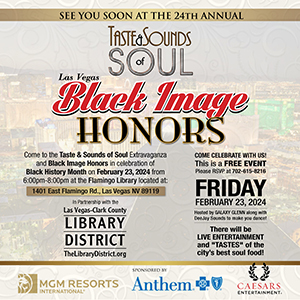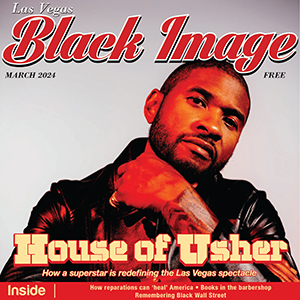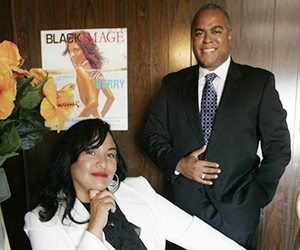Tribute to Historic Black Vegas!
February 3, 2014 by Las Vegas Black Image Magazine
Filed under Community, Feature, Photos
Two longtime residents share reflections of growing up black in Las Vegas
With the annual celebration of Black History Month now underway, it is the ideal time to reflect on the triumphs and sacrifices of African-Americans who migrated to Nevada in the early 20th century. They were true pioneers, men and women who left places across the United States as early as 1917 in search of a better life in the Silver State. We spoke to two people who arrived in Las Vegas as children in the 1930s, and asked them to share memories and observations from their front row seat to the unfolding history of modern Las Vegas.
ETTA McLEMORE HODGES
We moved to Las Vegas in 1939 because my dad, Louie Hodges, got a job at the magnesium plant that was operated by the federal government. I was just 4 years old at the time, and we came here from Arizona, but are originally from Mississippi. After my dad worked at the magnesium plant, he got a job to work on Boulder Dam — now called Hoover Dam. You know that big wall that goes down to the bottom of the dam? It was built by my dad and his brother.
My dad also owned the first black -owned cab company, Western Cab, with Dr. Charles West [the first black physician in Las Vegas] and two other gentlemen. Their cab company serviced the historic Westside area, because white-owned cab companies would not come to the Westside in the 1950s. My dad’s cab business was doing extremely well, and money was being generated. So other cab companies saw their success in the underserved market, and decided to move their businesses in the area — offering lower prices and more cabs. That eventually put Western Cab out of business.
Times were very different for African-Americans in Las Vegas back then. When my parents first arrived in Las Vegas, we lived with the Harris family in the downtown area. Many of the black people who lived in Las Vegas back then lived in the downtown area, they bought the land and built their own homes.
Most of the African-Americans who were already here, before many others who migrated from the South, worked on the railroad. The downtown area was considered shabby — so many sold their homes and bought land to build new ones on the historic Westside.
There is a myth that the African-Americans who first came to the Westside lived in tents because they were very poor. That is not true. Many lived in tents while they waited for the construction on their new homes to be completed. African-Americans were doing very well because of the good wages that were paid. The streets were not paved in the historic Westside, but they didn’t have paved streets on the other side of town either. There were no sidewalks, and I remember my dad putting a sidewalk down in front of our house. But none of this seemed to really bother us, because we had our own grocery store, cleaners, casinos and school on the Westside. We even had our own malt shop and hamburger restaurant.
My husband’s father came to Las Vegas in the 1920s, and he bought property and built a house in downtown Las Vegas. Many African-Americans lived in the downtown area, around the old post office building. But when the historic Westside was being developed, everyone knew it was a better place to live. Especially after Berkley Square was built, everyone wanted to move there. Fremont Street in downtown Las Vegas was mostly commercial. It was the only place in Las Vegas that had clothing stores, shoe stores, and a place where everyone went to shop.
I don’t remember experiencing [a lot of] prejudice while I was growing up. But when we went to the movies, they asked us to sit in a certain section — and, of course, we didn’t, but no one ever came over to bother us. Actually, going into the casinos downtown they didn’t want us there. I remember Mr. Huedillard Paris “H.P.” Fitzgerald was at Nellis Air Force Base, and he and a bunch of airmen came downtown and went into one of the casinos and said, “We are coming in and we are not leaving. We fight for this country and it is our right to go wherever we want.”
As African-Americans in Las Vegas you couldn’t live anywhere you wanted. You had to buy and build your own home on the Westside. Bonanza Village was there, but it had all white residents. The Westside was great and we had everything we needed. I remember every year many of the teenagers would gather at the War Memorial Building downtown and that is where we would have big concerts and the African-American celebrities such as Nat King Cole, Count Basie and Pearl Bailey would come there to perform. There were no gangs back then.
I attend the Pilgrim Church of Christ on D Street and Harrison Avenue, and that is the first black church on the Westside. It was built in 1927. That is the church most of the African-Americans attended at the time. Second Baptist Church was the second black church that was built, and it was pastored by Reverend Coleman. Reverend Coleman and Pastor Cox were great leaders of the community. Second Baptist Church would be standing room only when people knew Reverend Coleman would be singing at church service. Pastor Cox would go everywhere in the community, and you would even see him at the Brown Derby Club where people would dance on the table tops. He would say, “When you see me down there, it’s not that I’m dancing and having fun. It’s because there are souls there that need to be saved.”
I remember Vegas Heights being a great area with ranch-type homes in the historic Westside. My dad brought me my first pony from Mr. Owens, who was a rancher who lived there. Owens Street is named after him. He was a white man and Vegas Heights had only white residents back then. I remember our first black teachers, Mr. Henry Moore and Mr. Fitzgerald. The African-American children excelled in education, because the families really were involved in the schools and with the teachers.
I retired from the state of Nevada after 30 years and I have lived in Regal Estates housing development for 64 years. I have seen the changes to our community, but the historic Westside and how it looks now disappoints me. The redevelopment for the area has not taken place like other parts of Las Vegas. There was money that was targeted for the Westside community for redevelopment, but the city used it to save the bankrupt Main Street Station Hotel downtown. We need dedicated leaders who will stand up for the community; and if churches would work together, we will see more progress on the historic Westside. We don’t have the Bob Baileys, the Dr. Charles I. Wests, the Joe Neals, the Reverend Marion Bennetts any more. The young people don’t seem to care.
CORRECTION
In the February 2014 edition of Las Vegas Black Image, we erroneously reported the identity of Etta McLemore Hodges’ father. Her father is George McLemore, who once owned a cab company and worked alongside his brothers, and others, to help build the Boulder Dam. Louie Hodges was her father-in-law. We regret the error.
EUGENE BUFORD
I arrived in Las Vegas with my parents in 1932. I was maybe 3 or 4 years old, and we came from Birmingham, Ala. My parents came here looking for work, and black people were already in Vegas when we arrived. Most of them worked on the railroad that we called “The Shops,” and they would repair the train engines. The old railroad was located downtown, where the Plaza Hotel is now. There were black people who were working there, and my great-grandmother was here as well, who came to Las Vegas in 1917. Black people who came to Las Vegas got in touch with friends and relatives to know where to get jobs.
Many of the first African-Americans who came to Las Vegas lived in the downtown area. I lived on 3rd Street across from the Lucky Hotel, [near] the new Mob Museum. Many of the African-Americans who lived in the downtown area of Las Vegas owned their own property and paid their taxes. I can remember many talking about when their taxes were due. I don’t know exactly what happened, but [construction of] the Boulder Dam brought an influx of so many white people coming from the South to work on the dam, they bought the property from the blacks in downtown.
I am now 85 year of age, and I can remember a community pool that was downtown on 5th and Fremont. Until I was in the seventh grade, they didn’t have any blacks that would go to the pool to swim. The NAACP assisted in making the pool accessible for black people, but you could only go swimming during your physical education classes while you were in school. Black children weren’t allowed to swim in the pool on the weekend with the other kids during the weekend. Lorenzi Park also had a big pool, but blacks were not allowed to swim there when I was a young boy. I remember my eighth grade graduation, and there were only two of us [African-Americans] in the graduating class before we went to Las Vegas High School and they had a big party at Lorenzi Park. They told us that we … wouldn’t have any fun and couldn’t go swimming. In other words – don’t come.
Many people say that segregation was good, because we had more community wealth. But it wasn’t good. We wanted the jobs and the right to go wherever we wanted. The historic Westside did have businesses and markets on D Street. I remember working at one of the markets as a young man for Mr. Jones. There were casinos, pool halls and bars.
As I look at Las Vegas now, discrimination is very subtle. You can still be discriminated against, but we all know there have been improvements. But, in my opinion, we still have a hell of a ways to go. When I graduated from high school, the white kids were getting jobs with the police department, fire department, City Hall and at a few of the hotels – but no one was hiring you if you were black. We all went to high school together, but after school it was a whole different show. This is the reason I left Las Vegas to find work for a while. I returned to Vegas and eventually got a job at the Frontier Hotel, where I worked in the kitchen.
One of the things that I remember most about growing up in Las Vegas was the celebrated Helldorado Days. It seemed that everyone – blacks and whites – came together during this time and celebrated. It was like it was when I was in the fifth and sixth grades, when we all got along with everybody. I felt real comfortable then, but after the eighth grade I could see the racism and everything else coming into play. Once I went to Las Vegas High School, many of the whites that were my friends in grammar school started to pull away from me because of segregation. They weren’t as friendly as they were before; I could feel it and I knew it. I remember more vividly Helldorado Days – a happier time. My hope is that the community grows to be more unified and enjoys things together.



